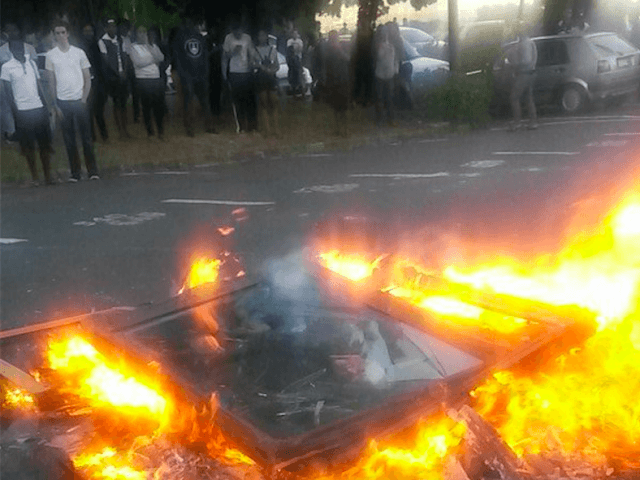Students at the University of Cape Town in South Africa ransacked university buildings Tuesday and set fire to paintings depicting white people, according to local news.
Offensive art depicting white people at the exclusion of blacks who have built UCT, going up in flames! #Shackville pic.twitter.com/E2H17W58fc
— VERNAC NEWS (@VernacNews) February 16, 2016
The students are part of a movement called Rhodes Must Fall, which has inspired a similar movement in the United Kingdom and also helped inspire the Black Lives Matter movement at campuses in the United States. They are protesting university fees, a lack of housing, and “whiteness.”
Tonight we witness the Black psyche unleashing generations of repressed pain. 2016 is the year we no longer pander to whiteness #Shackville
— Rhodes Must Fall (@RhodesMustFall) February 16, 2016
Last year, University of Cape Town students demanded the removal of a statue of Cecil John Rhodes, the British miner and imperialist who donated the land on which the university sits, on the dramatic slopes of Table Mountain. After weeks of protest that included throwing feces at the statue, the university caved to the students’ demands, and removed the statue.
Now, students at Oxford University in the UK are demanding a similar statue of Rhodes be removed, and that the name “Rhodes” be dropped from the prestigious Rhodes scholarships, which he endowed.
The latest protests at the University of Cape Town pick up where last year’s demonstrations left off–and faculty, administrators, and parents seem powerless to intervene. One student who was arrested is Thumi Molefe, the son of Brian Molefe, the CEO of South Africa’s parastatal power company, who made $250,000 in 2014, before bonus.
The students also built a shantytown called “Shackville,” which was eventually cleared by police, and destroyed and vandalized memorials to Jan Smuts.
Current mood : pic.twitter.com/r1E5clWHOO
— Rhodes Must Fall (@RhodesMustFall) February 16, 2016
Smuts was an Afrikaner general, prime minister and statesman who helped found the Union of South Africa, and is credited with founding the League of Nations after the First World War.
In addition, according to Times Live, students set fire to a shuttle bus and threw a Molotov cocktail into the office of university vice-chancellor Max Price, who has tried to mollify student protests, without success. One of the artists whose paintings were destroyed was Harriet Knight, who was reportedly distraught by the destruction:
“When I heard they were burnt, I thought: ‘Could they not have auctioned them?’
“I was crying quite a bit,” Knight said. “There was a lot of anger, but not just for the loss of my work. There was work by other people, like apartheid activists,” she said.
Knight, a former Rhodes University student who is now a teacher in the UK, was commissioned to paint the portrait of Rosemary Exner, a former warder at Fuller Hall student residence, when Knight was 19.
Knight said burning the work could derail the students’ cause.
“Had it been something that could forward this movement, I’d understand,” she said.
“People will remember you for what you build, not what you destroy.”
South Africa has been governed by the African National Congress (ANC), the party that led the struggle against apartheid, since the first multi-racial elections in 1994. The ANC often justifies its left-wing policies in racial terms, though historically it has tried to steer a course between confrontation and reconciliation with the white minority.
Fact: white people have destroyed and burned more artwork, culture, books than that little bonfire by @RhodesMustFall. Learn your history
— HJKim (@ennime) February 17, 2016
Recently, more radical movements have emerged, such as the Economic Freedom Fighters. The dominant political ethos in South Africa is socialist, with a new generation of students virtually indoctrinated with left-wing dogmas.

COMMENTS
Please let us know if you're having issues with commenting.